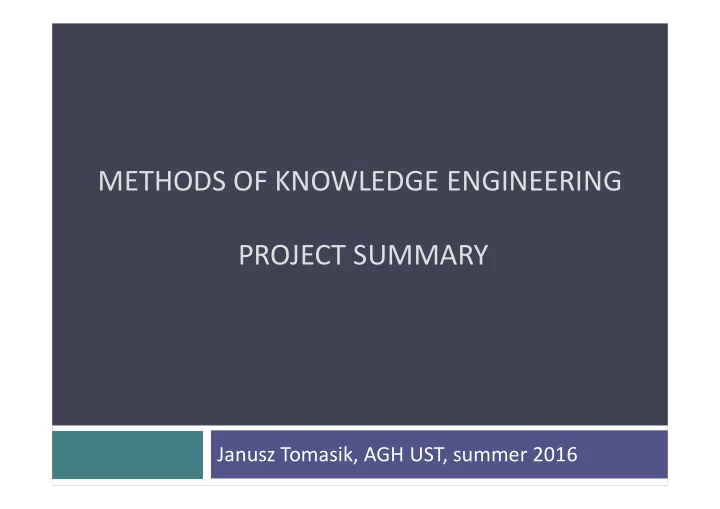

METHODS OF KNOWLEDGE ENGINEERING PROJECT SUMMARY Janusz Tomasik, AGH UST, summer 2016
Table of contents Introduction 1. Data exploration 2. The kNN method with cross-validation 3. Self-Organizing Maps 4. Associated Graph Data Structure (AGDS) 5. Summary 6.
1. Introduction 1 Zettabyte = 10 9 Terabytes
Big Data 2.7 Zettabytes of data existed in the digital world in 2012. 1 Only 0.5% of the data was analyzed. 2 1 https://www.marketingtechblog.com/ibm-big-data-marketing/ 2 http://www.emc.com/collateral/analyst-reports/idc-the-digital-universe-in-2020.pdf
2. Data Exploration Datasets: Conclusions: Benefits: • Transactions • Patterns • Recommendation engines • Search queries • Correlation • Items location • Messages • Frequency • Pricing improovement
Definitions Support - the frequency (in percentage) that an item occurs in the transactions Example: milk - occurs in 8 transactions out of 10 => Support(milk) = 80% Confidence - a conditional probability p(X|Y) (if a transaction has X, what is the probability that it has Y) Example: transaction 1: milk, coffee, cheese transaction 2: milk, sugar transaction 3: coffee, cheese Confidence (milk|sugar) is 50% Association rules - X -> Y (s,c) where s is support (X) and c is confidence(X|Y)
Simulation How to run the simulation Command line: (your_directory) java –jar association_rules.jar Print the dataset: Print all association rules with support>= 55 and confidence >= 60:
3. The kNN method with cross-validation https://en.wikipedia.org/wiki/K-nearest_neighbors_algorithm
Cross-validation http://stackoverflow.com/questions/31947183/how-to-implement-walk-forward-testing-in-sklearn
Datasets: dataset: records: classes: parameters: IrisDataAll 150 3 4 Wine 178 3 13 YeastShort 309 10 8 Classes distribution: POX; 4 VAC; 4 NUC; 71 CYT; 98 Wine 3; 48 Wine 1; 59 Iris-setosa; Iris-virginica; 50 50 ERL; 2 MIT; 75 Wine 2; 71 EXC; 9 Iris- ME3; 29 versicolor; ME1; 5 50 ME2; 12 Wine YeastShort IrisDataAll
Simulation How to run the simulation Command line: (your_directory) java –jar knn-classification-method.jar (your_directory) java – jar knn_with_cross_validation.jar Print the dataset: Perform cross-validation
Guess comparison: Guess correctness as a function of K-value - compared 1 0,9 0,8 Correctness Wine 0,7 Yeast Iris 0,6 0,5 0,4 1 11 21 31 41 51 61 71 81 91 101 111 121 131 141 K -value
Calculations performance: 55 y = 0,0014x 2 - 0,3709x + 26,577 50 45 40 35 Time (s) 30 25 20 15 10 5 - 120 170 220 270 320 Number of records
Observations: Guess correctness generally decreases non-monotonically with an 1. increasing K-value Guess correctness gets worse if the classes are not even distributed 2. The performance of kNN method implementation is O(n 2 ) 3.
4. Self-Organizing Maps Kohonen’s SOM enable to represent multidimensional data in fewer dimensions, i.e. two-dimensional unsupervised learning method one node can map multiple objects
Simulation How to run the simulation Command line: (your_directory) java –jar SOM.jar SOM after learning: SOM before learning:
5. Associated Graph Data Structure A passive data structure, which can substitute operations like: filtering, searching or ordering by providing them in O(1) No duplicates or excess data Faster data access
Simulation How to run the simulation Command line: (your_directory) java –jar AGDS.jar Finding the similar elements: (your_directory) java –jar AGDS_DB.jar Finding an element with exact values:
Tables vs Graphs Tested database: US Baseball Players Season Statistics Number of records: 14 347 Number of columns: 21 Tested database structures: Relational (MySQL) - Graph (AGDS) -
SELECT query Full query: SELECT * FROM `appearances` WHERE yearID = "1871„ Time performance: MySQL AGH - online AGDS with print AGDS w/o print MySQL - localhost (ms) (ms) (ms) (ms) 37,3 0,7 0,8 22 23 19 0 0 1 250 125 250 Results – SQL 115 rows: Results – AGDS 115 rows:
SELECT query with conjunction (AND) Full query: SELECT * FROM `appearances` WHERE yearID = "1871" AND teamID = "CH1" AND G_p = "0" AND G_defense = "26„ Time performance: MySQL AGH - online AGDS with print AGDS w/o print MySQL - localhost (ms) (ms) (ms) (ms) 39,8 37,2 41,9 1 1 1 1 1 1 249 328 281 Results – SQL 2 rows: Results – AGDS 2 rows:
SELECT query with conjunction (AND) 2nd test Full query: SELECT * FROM `appearances` WHERE yearID = "1908" AND lgID = "NL„ Time performance: MySQL AGH - online AGDS with print AGDS w/o print MySQL - localhost (ms) (ms) (ms) (ms) 39,3 28,4 291 46 47 41 1 1 1 1232 47 296 Results – SQL 233 rows: Results – AGDS 233 rows:
SELECT query with disjunction (OR) Full query: SELECT * FROM `appearances` WHERE yearID = "1871" OR teamID = "CH1" OR G_p = "0" OR G_defense = "26„ Time performance: MySQL AGH - online AGDS with print AGDS w/o print MySQL - localhost (ms) (ms) (ms) (ms) 91,8 0,8 0,7 994 1331 1275 11 14 11 16 32 15 Results – SQL 9312 rows Results – AGDS 9312 rows
Observations: The AGDS gives an edge over SQL in conjuction (AND) SELECT query 1. cases The performed tests have shown a correct AGDS queries 2. implementation (not proved yet!) Constant access time for simple AGDS SELECT queries 3.
6. Summary Effectively handling Big Data will be the challenge of the next years Solutions: Both hardware (i.e. quantum computers) & software (better data structures and algorithms) Data exploration (data mining) and machine learning requires a sophisticated approach.
Recommend
More recommend